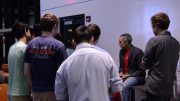IN2 is a popular location for many club meetings and events, catering to both the IMSA student body and external guests. It is IMSA’s entrepreneurship hub and home to the Makerspace. But in addition to all this, IN2 also provides financial backing for many internal projects and research studies from sources such as the ComEd Seed Fund. Each year, IN2’s partner ComEd donates money to IN2 to help fund student and faculty projects that work towards IMSA’s mission statement of “advancing the human condition” – specifically, the United Nations Sustainability Goals. Yet another avenue for scientific and technological discovery within IMSA, Seed Fund grants range in value from $200 to $2,500.
Grant presentations took place during midday on Thursday, March 22nd before spring break, allowing IMSA students to attend during their lunch break to glean insights and inspiration from previous grant winners.
Faculty-presented projects included:
- Reference & Collection Development Librarian Ms. Connie James-Jenkin, representing IMSA’s Information Resource Center (IRC). The IRC received $250 in order to purchase new titles for an “Go Green!” themed book display and for use at the NOAA Conference in February.
- Biology teacher Dr. Sowmya Anjur presented a method of using an Arduino as a heart-rate monitor, a creative incorporation of programming into advanced biology electives. Wired to a commercial heart-rate monitor, the Arduino’s LED would flash in sync with the subject’s heartbeat, and output beats per minute (BPM) on its display screen.
- Chemistry faculty Dr. Angela Ahrendt and Dr. John Thurmond collaborated on research on fluorescence spectroscopy and biodiesel as a renewable energy source. The experiment involved testing three different plant species for the amount of ethanol that could be extracted from them. Currently humans’ main source of ethanol is corn, but ethanol is more energy-efficient as, unlike corn, it is not a source of food for humans. In the future, this project will be run as an Independent Study for two students who requested a study with Drs. Ahrendt and Thurmond.
- Physics faculty Dr. Peter Clancy and Dr. Mark Carlson optimized the energy usage of microcontrollers (Arduinos).
- Lab Manager Dr. Julie Polz’s experiment, like Drs. Ahrendt and Thurmond’s, investigated an energy-efficient method to produce biodiesel, through the use of microalgae spirulina.
Student-presented projects included:
- Darius Hong’s (’18) experiment titled “Functional Characterization of Cellobiase with Chemical Kinetic Techniques,” which measured the optimal pH, temperature, and pressure for cellobiase enzyme efficiency.
- Club Terra, IMSA’s environmental protection club, founded the Green Ambassador program at IMSA this past fall. The organization aims to “inspire children [across the state] about environmental and energy issues,” according to club president Parth Dhyani (’18). Green Ambassadors host fun, environment-themed programs for children at their local libraries. After receiving the Seed Fund grant for the first time last year, Club Terra reapplied for funding to purchase more materials for the program. The project was sponsored by biology teacher Dr. Don Dosch.
The ComEd fund is just one way that IMSA works to fund its students’ ideas and innovation. The IMSA Ideas Award and the Scott Swanson Fund are two more sources of funding that IMSA students, faculty, and staff can apply for.
The ComEd Seed Fund Grant will be awarded again this year (applications can be found here for interested students). Dhyani commented on the application process, “We spent about 2 weeks filling out the application, because it is quite comprehensive. We are being trusted with large amounts of money…so it’s important to write the best possible application.”
The grant encourages IMSA students and faculty to develop their own projects around the theme of renewable energy, and helps to eliminate potential financial barriers. Dr. Ahrendt, as a teacher of Environmental Chemistry, noted that the Seed Fund’s focus on energy “was a perfect fit for the curriculum” and required “less effort than searching for other grant opportunities since it is advertised internally.”






Be the first to comment on "IN2 Funding for Innovation: ComEd Grant Presentations"